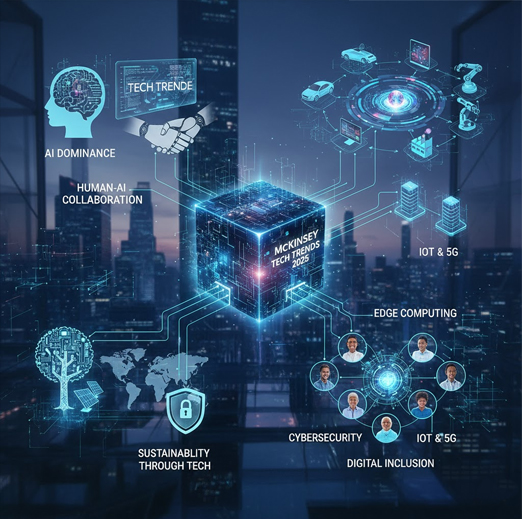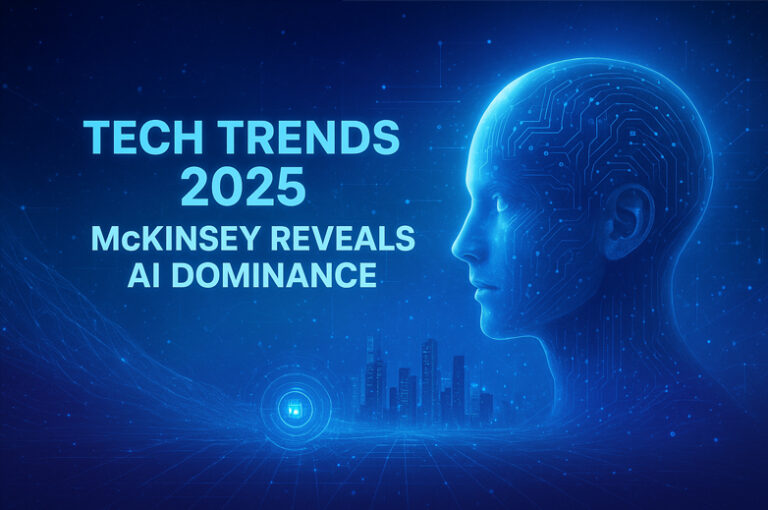Premium Biz Post – As 2025 unfolds, the technological landscape continues to evolve faster than ever before. According to McKinsey & Company’s latest Technology Trends Outlook 2025, the world is entering an era where AI dominance and digital transformation are no longer optional — they are fundamental to competitiveness. The report highlights how artificial intelligence, edge computing, and next-generation automation will define how businesses innovate, grow, and survive in the coming years.

Artificial Intelligence: From Buzzword to Business Backbone
Artificial Intelligence (AI) has matured from an experimental technology to a core driver of global industries. McKinsey’s research shows that AI adoption has grown exponentially, with more than 60% of global enterprises using AI in at least one function. What started as automation for data analysis has now become a multi-faceted tool powering predictive insights, customer engagement, and strategic decision-making.
Generative AI, in particular, has seen rapid evolution. Companies are integrating large language models (LLMs) into customer service, marketing, and software development. This democratization of AI tools has reduced barriers to entry, allowing smaller firms to leverage the same level of intelligence as global tech giants.
However, this dominance brings challenges — ethical considerations, bias in data, and job displacement. McKinsey emphasizes that while AI will generate trillions in value, organizations must balance efficiency with responsibility.
The Rise of Edge Computing and Decentralized Data
As the world becomes more connected, centralized cloud systems are facing strain. Edge computing — where data processing happens closer to the source — is now critical. The McKinsey report outlines how edge infrastructure reduces latency, enhances security, and enables real-time analytics, especially in manufacturing, healthcare, and autonomous transport.
Imagine a future where self-driving cars communicate instantly with nearby vehicles, or hospitals process patient scans in milliseconds without sending data to remote servers. This is the promise of edge computing: speed, precision, and data sovereignty.
For companies, it means lower bandwidth costs and greater resilience against cyberattacks. For consumers, it translates to faster, more responsive digital experiences. McKinsey forecasts that by 2030, more than 75% of enterprise data will be processed outside centralized data centers — a fundamental shift in how digital ecosystems operate.
Digital Transformation: From Project to Culture
In 2025, digital transformation is no longer a project with a deadline — it’s a continuous cultural shift. Businesses that once viewed digital tools as optional add-ons now see them as vital to survival. The COVID-19 pandemic accelerated this trend, forcing organizations to reimagine operations, workforce management, and customer engagement through digital-first strategies.
McKinsey notes that companies with strong digital foundations outperform competitors by up to 50% in operational efficiency and revenue growth. Digital transformation now extends beyond adopting new software; it encompasses retraining employees, rethinking leadership, and redesigning workflows.
Moreover, the future workforce will need hybrid skills — combining technical literacy with creativity and empathy. As automation takes over repetitive tasks, human workers will increasingly focus on strategic and emotional intelligence roles.
Read More : ”Unique Technology Based Creations Creativity in the Digital Era”
Sustainability Through Tech Innovation
One of the standout themes in McKinsey’s 2025 report is the integration of sustainability and technology. Green computing, carbon tracking software, and energy-efficient data centers are gaining traction as organizations aim to align profit with planet.
Artificial intelligence is playing a major role here too. Predictive algorithms can optimize energy consumption, reduce waste, and improve logistics efficiency. Cloud providers like Microsoft and Google are racing toward carbon-neutral data centers powered by renewable sources.
This intersection of sustainability and technology is not just a trend — it’s a necessity. Regulators, investors, and consumers are increasingly rewarding companies that prioritize environmental responsibility alongside innovation.
Cybersecurity in a Hyperconnected World
As digital ecosystems expand, cybersecurity has never been more crucial. McKinsey’s report warns that while AI and automation boost productivity, they also open new attack vectors. The rise of quantum computing could render current encryption obsolete, while deepfake technologies threaten the integrity of information.
To combat this, organizations are adopting “zero-trust” frameworks — assuming every device and user could be compromised until proven safe. Investment in AI-powered threat detection is also rising, enabling real-time monitoring and automatic incident response.
The report predicts that cybersecurity spending will surpass $300 billion annually by 2030, highlighting its growing importance in both the private and public sectors.
The AI Workforce: Collaboration Between Humans and Machines
As AI systems become more capable, the question arises: what happens to the human workforce? McKinsey envisions a collaborative future — one where AI acts as an intelligent partner, not a replacement. In this future, repetitive and data-heavy tasks are handled by machines, while humans focus on creativity, empathy, and critical thinking.
This collaboration requires upskilling on a global scale. McKinsey estimates that by 2030, over 800 million workers worldwide will need retraining to adapt to AI-driven roles. Governments, universities, and corporations must work together to create flexible learning systems that keep pace with technological evolution.
AI literacy will be as essential as basic computer literacy once was. Understanding how to prompt, evaluate, and manage AI tools will be a key skill for employees in every industry.
5G, IoT, and the Internet of Everything
The next stage of connectivity goes beyond smartphones and smart homes. With 5G networks now mainstream, the Internet of Things (IoT) is expanding into agriculture, logistics, and smart cities. McKinsey highlights that IoT-enabled ecosystems could contribute more than $12 trillion in global economic value by 2030.
In agriculture, sensors can monitor soil conditions in real-time, optimizing crop yields. In logistics, IoT helps track shipments with pinpoint accuracy, reducing delays and losses. Meanwhile, smart cities are using interconnected devices to manage traffic, waste, and energy consumption more efficiently.
This convergence of AI, IoT, and 5G will redefine what it means to live in a digital world — where everything, from streetlights to refrigerators, becomes intelligent and interconnected.
Quantum Computing and the Next Frontier
Quantum computing, though still in its early stages, is poised to revolutionize data processing. McKinsey’s report identifies it as one of the top ten transformative technologies to watch. By manipulating subatomic particles to perform complex calculations at incredible speeds, quantum computing could solve problems that are impossible for classical systems.
From drug discovery to climate modeling, quantum computing could unlock answers to humanity’s most challenging questions. Tech giants like IBM, Google, and startups such as IonQ are investing billions to make quantum computing commercially viable within the next decade.
However, the path ahead is complex. Quantum stability, error correction, and energy demands remain major obstacles. McKinsey advises that while mass adoption may be years away, early investment in research and talent will position businesses for future breakthroughs.
Global Tech Disparities and Digital Inclusion
While advanced economies are racing ahead, McKinsey warns of widening digital inequality. Billions of people in developing countries still lack access to high-speed internet, digital education, or modern infrastructure. This gap threatens to deepen economic divides and limit the global benefits of technological progress.
To address this, governments and private sectors must collaborate on affordable connectivity and digital literacy initiatives. Emerging technologies such as low-earth orbit (LEO) satellites could help bridge the gap by providing broadband access to remote regions.
Digital inclusion is not only a moral imperative but also an economic one — as connected populations contribute directly to innovation and growth.
McKinsey’s Tech Trends 2025 paints a clear picture: the digital revolution is accelerating, and adaptation is no longer optional. From AI and edge computing to sustainability and quantum breakthroughs, the technologies reshaping our world are interlinked and evolving fast.
For business leaders, the message is urgent — invest in technology, talent, and ethical frameworks today, or risk being left behind tomorrow.
For individuals, it’s about embracing lifelong learning, leveraging AI responsibly, and understanding that in this new era, agility and adaptability are the true measures of success.
In the end, the AI dominance that McKinsey describes is not about machines overtaking humanity, but about empowering humans to achieve more through intelligent collaboration. The future will belong to those who learn to work with technology — not against it.



